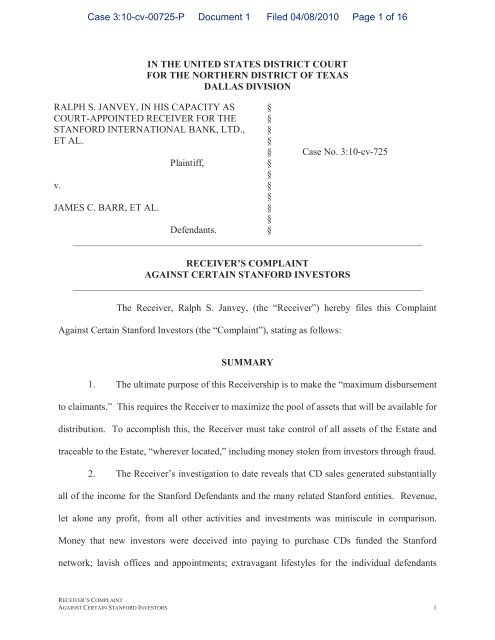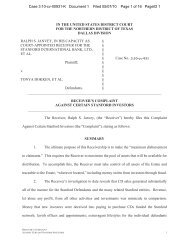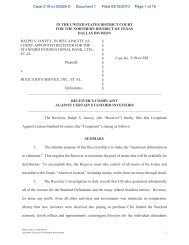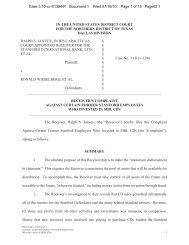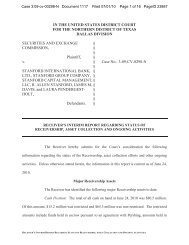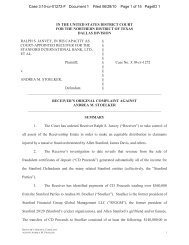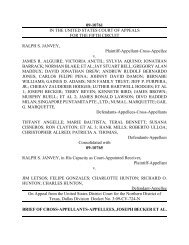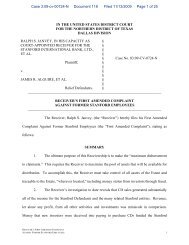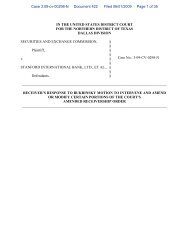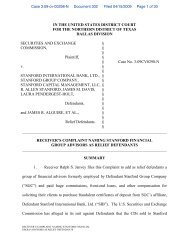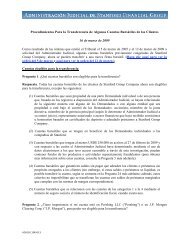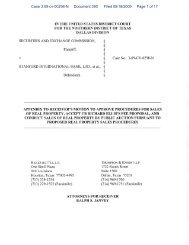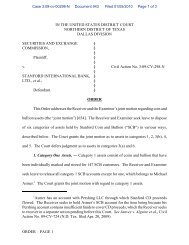Receiver's Additional Complaint Against Certain Investors - Stanford ...
Receiver's Additional Complaint Against Certain Investors - Stanford ...
Receiver's Additional Complaint Against Certain Investors - Stanford ...
You also want an ePaper? Increase the reach of your titles
YUMPU automatically turns print PDFs into web optimized ePapers that Google loves.
Case 3:10-cv-00725-P Document 1 Filed 04/08/2010 Page 1 of 16<br />
IN THE UNITED STATES DISTRICT COURT<br />
FOR THE NORTHERN DISTRICT OF TEXAS<br />
DALLAS DIVISION<br />
RALPH S. JANVEY, IN HIS CAPACITY AS §<br />
COURT-APPOINTED RECEIVER FOR THE §<br />
STANFORD INTERNATIONAL BANK, LTD., §<br />
ET AL.<br />
§<br />
§ Case No. 3:10-cv-725<br />
Plaintiff,<br />
§<br />
§<br />
v.<br />
§<br />
§<br />
JAMES C. BARR, ET AL.<br />
§<br />
§<br />
Defendants.<br />
§<br />
________________________________________________________________________<br />
RECEIVER’S COMPLAINT<br />
AGAINST CERTAIN STANFORD INVESTORS<br />
________________________________________________________________________<br />
The Receiver, Ralph S. Janvey, (the “Receiver”) hereby files this <strong>Complaint</strong><br />
<strong>Against</strong> <strong>Certain</strong> <strong>Stanford</strong> <strong>Investors</strong> (the “<strong>Complaint</strong>”), stating as follows:<br />
SUMMARY<br />
1. The ultimate purpose of this Receivership is to make the “maximum disbursement<br />
to claimants.” This requires the Receiver to maximize the pool of assets that will be available for<br />
distribution. To accomplish this, the Receiver must take control of all assets of the Estate and<br />
traceable to the Estate, “wherever located,” including money stolen from investors through fraud.<br />
2. The Receiver’s investigation to date reveals that CD sales generated substantially<br />
all of the income for the <strong>Stanford</strong> Defendants and the many related <strong>Stanford</strong> entities. Revenue,<br />
let alone any profit, from all other activities and investments was miniscule in comparison.<br />
Money that new investors were deceived into paying to purchase CDs funded the <strong>Stanford</strong><br />
network; lavish offices and appointments; extravagant lifestyles for the individual defendants<br />
RECEIVER’S COMPLAINT<br />
AGAINST CERTAIN STANFORD INVESTORS 1
Case 3:10-cv-00725-P Document 1 Filed 04/08/2010 Page 2 of 16<br />
and their families; employees’ salaries; Loans, SIBL CD commissions, SIBL Quarterly Bonuses,<br />
Performance Appreciation Rights Plan (“PARS”) Payments, Branch Managing Director<br />
Quarterly Compensation, and Severance Payments to financial advisors, managing directors, and<br />
other <strong>Stanford</strong> employees; and CD proceeds in the form of purported CD interest payments and<br />
redemptions (“CD Proceeds”) to the investors named in the concurrently filed Appendix (the<br />
“<strong>Stanford</strong> <strong>Investors</strong>”).<br />
3. The <strong>Stanford</strong> <strong>Investors</strong> not only received from SIBL sums equal to their<br />
investments in SIBL CDs, but they also received payments in excess of their respective<br />
investments. The CD Proceeds the <strong>Stanford</strong> <strong>Investors</strong> received from SIBL were not, in fact, their<br />
actual principal or interest earned on the funds they invested. Instead, the money used to make<br />
those payments came directly from the sale of SIBL CDs to other investors.<br />
4. When <strong>Stanford</strong> made purported CD principal and interest payments to the<br />
<strong>Stanford</strong> <strong>Investors</strong>, he did no more than take money out of other investors’ pockets and put it into<br />
the hands of the <strong>Stanford</strong> <strong>Investors</strong>. For the more than 20,000 investors who have thus far<br />
received little or nothing from their investment in <strong>Stanford</strong> CDs, money recovered from<br />
wherever it resides today is likely the largest portion of the money they will ever receive in<br />
restitution. CD Proceeds — comprising purported CD principal and interest payments to the<br />
<strong>Stanford</strong> <strong>Investors</strong> — are little more than stolen money and do not belong to the <strong>Stanford</strong><br />
<strong>Investors</strong> who received such funds but belong, instead, to the Receivership Estate.<br />
5. At this stage of the Receivership, the Receiver has identified substantial sums of<br />
CD Proceeds paid to the <strong>Stanford</strong> <strong>Investors</strong> and, through this <strong>Complaint</strong>, seeks the return of<br />
those funds to the Receivership Estate in order to make an equitable distribution to claimants. 1<br />
1<br />
The Receiver’s claims in this <strong>Complaint</strong> are related to his claims against other <strong>Stanford</strong> <strong>Investors</strong> on file<br />
RECEIVER’S COMPLAINT<br />
AGAINST CERTAIN STANFORD INVESTORS 2
Case 3:10-cv-00725-P Document 1 Filed 04/08/2010 Page 3 of 16<br />
At a minimum, the <strong>Stanford</strong> <strong>Investors</strong> named in the Appendix received over $19.6 million in CD<br />
Proceeds.<br />
6. The Receiver seeks an order that: (a) CD Proceeds received directly or indirectly<br />
by the <strong>Stanford</strong> <strong>Investors</strong> from fraudulent CDs were fraudulent transfers or, in the alternative,<br />
unjustly enriched the <strong>Stanford</strong> <strong>Investors</strong>; (b) CD Proceeds received directly or indirectly by the<br />
<strong>Stanford</strong> <strong>Investors</strong> from fraudulent CDs are property of the Receivership Estate held pursuant to<br />
a constructive trust for the benefit of the Receivership Estate; (c) each of the <strong>Stanford</strong> <strong>Investors</strong><br />
is liable to the Receivership Estate for an amount equaling the CD Proceeds he, she, or it<br />
received; and (d) awards attorney’s fees and costs to the Receiver.<br />
PARTIES<br />
7. The parties to this <strong>Complaint</strong> are the Receiver and the <strong>Stanford</strong> <strong>Investors</strong> named<br />
in the Appendix filed concurrently herewith.<br />
8. The named <strong>Stanford</strong> <strong>Investors</strong> will be served pursuant to the Federal Rules of<br />
Civil Procedure, through their attorneys of record, or by other means approved by order of this<br />
Court.<br />
JURISDICTION & VENUE<br />
9. This Court has jurisdiction over this action, and venue is proper, under Section<br />
22(a) of the Securities Act (15 U.S.C. § 77v(a)), Section 27 of the Exchange Act (15 U.S.C.<br />
§ 78aa), and under Chapter 49 of Title 28, Judiciary and Judicial Procedure (28 U.S.C. § 754).<br />
10. Further, as the Court that appointed the Receiver, this Court has jurisdiction over<br />
any claim brought by the Receiver to execute his Receivership duties.<br />
in Case Nos. 03:09-CV-0724-N, 03:10-CV-0366-N, 03:10-CV-0415-N, 03:10-CV-0478-N, 03:10-CV-0528-N, and<br />
03:10-CV-0617-N before this Court.<br />
RECEIVER’S COMPLAINT<br />
AGAINST CERTAIN STANFORD INVESTORS 3
Case 3:10-cv-00725-P Document 1 Filed 04/08/2010 Page 4 of 16<br />
11. Further, within 10 days of his appointment, the Receiver filed the original<br />
<strong>Complaint</strong> and Order Appointing the Receiver in 29 United States district courts pursuant to 28<br />
U.S.C. § 754, giving this Court in rem and in personam jurisdiction in each district where the<br />
<strong>Complaint</strong> and Order have been filed.<br />
12. Further, any of the <strong>Stanford</strong> <strong>Investors</strong> who submitted an Application for Review<br />
and Potential Release of <strong>Stanford</strong> Group Company (“SGC”) Brokerage Accounts made the<br />
following declaration: “By filing this application, I submit to the exclusive jurisdiction of the<br />
United States District Court for the Northern District of Texas, Dallas Division and irrevocably<br />
waive any right I or any entity I control may otherwise have to object to any action being brought<br />
in the Court or to claim that the Court does not have jurisdiction over the matters relating to my<br />
account.”<br />
13. Further, any of the <strong>Stanford</strong> <strong>Investors</strong> who filed motions to intervene in SEC v.<br />
<strong>Stanford</strong> International Bank, Ltd., et al., Case No. 3:09-cv-298-N, have consented as a matter of<br />
law to the Court’s personal jurisdiction. See In re Bayshore Ford Trucks Sales, Inc., 471 F.3d<br />
1233, 1246 (11th Cir. 2006); County Sec. Agency v. Ohio Dep’t of Commerce, 296 F.3d 477, 483<br />
(6th Cir. 2002); Pharm. Research & Mfrs. v. Thompson, 259 F. Supp. 2d 39, 59 (D.D.C. 2003);<br />
City of Santa Clara v. Kleppe, 428 F. Supp. 315, 317 (N.D. Ca. 1976).<br />
STATEMENT OF FACTS<br />
14. On February 16, 2009, the Securities and Exchange Commission commenced a<br />
lawsuit in this Court against R. Allen <strong>Stanford</strong>, two associates, James M. Davis and Laura<br />
Pendergest-Holt, and three of Mr. <strong>Stanford</strong>’s companies, <strong>Stanford</strong> International Bank, Ltd.<br />
(“SIB,” “SIBL,” or “the Bank”), SGC, and <strong>Stanford</strong> Capital Management, LLC (collectively, the<br />
“<strong>Stanford</strong> Defendants”). On the same date, the Court entered an Order appointing a Receiver,<br />
RECEIVER’S COMPLAINT<br />
AGAINST CERTAIN STANFORD INVESTORS 4
Case 3:10-cv-00725-P Document 1 Filed 04/08/2010 Page 5 of 16<br />
Ralph S. Janvey, over all property, assets, and records of the <strong>Stanford</strong> Defendants, and all entities<br />
they own or control.<br />
15. As alleged by the SEC, the <strong>Stanford</strong> Defendants marketed fraudulent SIBL CDs<br />
to investors exclusively through SGC financial advisors pursuant to a Regulation D private<br />
placement. SEC’s Second Amended <strong>Complaint</strong> (Doc. 952), 27. 2<br />
The CDs were sold by<br />
<strong>Stanford</strong> International Bank, Ltd. Id.<br />
16. The <strong>Stanford</strong> Defendants orchestrated and operated a wide-ranging Ponzi scheme.<br />
Defendant James M. Davis has admitted that the <strong>Stanford</strong> fraud was a Ponzi scheme from the<br />
beginning. Doc. 771 (Davis Plea Agreement) at 17(n) (<strong>Stanford</strong>, Davis, and other conspirators<br />
created a “massive Ponzi scheme”); Doc. 807 (Davis Tr. of Rearraignment) at 16:16-17, 21:6-8,<br />
21:15-17 (admitting the <strong>Stanford</strong> Ponzi fraud was a “massive Ponzi scheme ab initio”).<br />
17. In marketing, selling, and issuing CDs to investors, the <strong>Stanford</strong> Defendants<br />
repeatedly touted the CDs’ safety and security and SIBL’s consistent, double-digit returns on its<br />
investment portfolio. SEC’s Second Amended <strong>Complaint</strong> (Doc. 952) at 32-33.<br />
18. In its brochure, SIBL told investors, under the heading “Depositor Security,” that<br />
its investment philosophy is “anchored in time-proven conservative criteria, promoting stability<br />
in [the Bank’s] certificate of deposit.” SIBL also emphasized that its “prudent approach and<br />
methodology translate into deposit security for our customers.” Id. 34. Further, SIBL stressed<br />
the importance of investing in “marketable” securities, saying that “maintaining the highest<br />
degree of liquidity” was a “protective factor for our depositors.” Id.<br />
19. In its 2006 and 2007 Annual Reports, SIBL told investors that the Bank’s assets<br />
were invested in a “well-balanced global portfolio of marketable financial instruments, namely<br />
2<br />
Unless otherwise stated, citations to Court records herein are from the case styled SEC v. <strong>Stanford</strong> Int’l<br />
Bank, Ltd., et al., Civil Action No. 3-09-CV-0298-N.<br />
RECEIVER’S COMPLAINT<br />
AGAINST CERTAIN STANFORD INVESTORS 5
Case 3:10-cv-00725-P Document 1 Filed 04/08/2010 Page 6 of 16<br />
U.S. and international securities and fiduciary placements.” Id. 35. More specifically, SIBL<br />
represented that its year-end 2007 portfolio allocation was 58.6% equity, 18.6% fixed income,<br />
7.2% precious metals, and 15.6% alternative investments. Id.<br />
20. Consistent with its Annual Reports and brochures, SIBL trained SGC financial<br />
advisors, in February 2008, that “liquidity/marketability of SIB’s invested assets” was the “most<br />
important factor to provide security to SIB clients.” Id. 36. In training materials, the <strong>Stanford</strong><br />
Defendants also claimed that SIBL had earned consistently high returns on its investment of<br />
deposits (ranging from 11.5% in 2005 to 16.5% in 1993). Id. 49.<br />
21. Contrary to the <strong>Stanford</strong> Defendants’ representations regarding the liquidity of its<br />
portfolio, SIBL did not invest in a “well-diversified portfolio of highly marketable securities.”<br />
Instead, significant portions of the Bank’s portfolio were misappropriated by Defendant Allen<br />
<strong>Stanford</strong> and were either placed in speculative investments (many of them illiquid, such as<br />
private equity deals), diverted to other <strong>Stanford</strong> Entities “on behalf of shareholder” - i.e., for the<br />
benefit of Allen <strong>Stanford</strong>, or used to finance Allen <strong>Stanford</strong>’s lavish lifestyle (e.g., jet planes, a<br />
yacht, other pleasure craft, luxury cars, homes, travel, company credit card, etc.). In fact, at<br />
year-end 2008, the largest segments of the Bank’s portfolio were at least $1.6 billion in<br />
undocumented “loans” to Defendant Allen <strong>Stanford</strong>; private equity; and over-valued real estate.<br />
Id. 39-40.<br />
22. In an effort to conceal their fraud and ensure that investors continued to purchase<br />
the CD, the <strong>Stanford</strong> Defendants fabricated the performance of SIBL’s investment portfolio. Id.<br />
4.<br />
23. SIBL’s financial statements, including its investment income, were fictional. Id.<br />
4, 53. In calculating SIBL’s investment income, Defendants <strong>Stanford</strong> and James Davis<br />
RECEIVER’S COMPLAINT<br />
AGAINST CERTAIN STANFORD INVESTORS 6
Case 3:10-cv-00725-P Document 1 Filed 04/08/2010 Page 7 of 16<br />
provided to SIBL’s internal accountants a pre-determined return on investment for the Bank’s<br />
portfolio. Id. Using this pre-determined number, SIBL’s accountants reverse-engineered the<br />
Bank’s financial statements to reflect investment income that SIBL did not actually earn. Id.<br />
24. CD Proceeds from the Ponzi scheme were transferred by the <strong>Stanford</strong> Defendants<br />
to the <strong>Stanford</strong> <strong>Investors</strong> solely for the purpose of concealing and perpetuating the fraudulent<br />
scheme. Such CD Proceeds were paid to the <strong>Stanford</strong> <strong>Investors</strong> from funds supplied by other<br />
investors who bought the fraudulent CDs.<br />
25. For a time, the <strong>Stanford</strong> Defendants were able to keep the fraud going by using<br />
funds from current sales of SIBL CDs to make purported interest and redemption payments on<br />
pre-existing CDs. See id. 1. However, in late 2008 and early 2009, CD redemptions increased<br />
to the point that new CD sales were inadequate to cover redemptions and normal operating<br />
expenses. As the depletion of liquid assets accelerated, this fraudulent Ponzi scheme collapsed.<br />
REQUESTED RELIEF<br />
26. This Court appointed Ralph S. Janvey as Receiver for the “assets, monies,<br />
securities, properties, real and personal, tangible and intangible, of whatever kind and<br />
description, wherever located, and the legally recognized privileges (with regard to the entities),<br />
of the Defendants and all entities they own or control,” including those of the <strong>Stanford</strong> Group<br />
Company brokerage firm. Order Appointing Receiver (Doc. 10) at 1-2; Amended Order<br />
Appointing Receiver (Doc. 157) at 1-2. The Receiver seeks the relief described below in this<br />
capacity.<br />
27. Paragraph 4 of the Order Appointing Receiver, entered by the Court on February<br />
16, 2009, authorizes the Receiver “to immediately take and have complete and exclusive control,<br />
possession, and custody of the Receivership Estate and to any assets traceable to assets owned by<br />
RECEIVER’S COMPLAINT<br />
AGAINST CERTAIN STANFORD INVESTORS 7
Case 3:10-cv-00725-P Document 1 Filed 04/08/2010 Page 8 of 16<br />
the Receivership Estate.”<br />
Order Appointing Receiver (Doc. 10) at 4; Amended Order<br />
Appointing Receiver (Doc. 157) at 4. Paragraph 5(c) of the Order specifically authorizes the<br />
Receiver to “[i]nstitute such actions or proceedings [in this Court] to impose a constructive trust,<br />
obtain possession, and/or recover judgment with respect to persons or entities who received<br />
assets or records traceable to the Receivership Estate.” Order Appointing Receiver (Doc. 10) at<br />
5(c); Amended Order Appointing Receiver (Doc. 157) at 5(c).<br />
28. One of the Receiver’s key duties is to maximize distributions to defrauded<br />
investors and other claimants. See Amended Order Appointing Receiver (Doc. 157) at 5(g), (j)<br />
(ordering the Receiver to “[p]reserve the Receivership Estate and minimize expenses in<br />
furtherance of maximum and timely disbursement thereof to claimants”); Scholes v. Lehmann, 56<br />
F.3d 750, 755 (7th Cir. 1995) (receiver’s “only object is to maximize the value of the [estate<br />
assets] for the benefit of their investors and any creditors”); SEC v. TLC Invs. & Trade Co., 147<br />
F. Supp. 2d 1031, 1042 (C.D. Cal. 2001); SEC v. Kings Real Estate Inv. Trust, 222 F.R.D. 660,<br />
669 (D. Kan. 2004). But before the Receiver can attempt to make victims whole, he must locate<br />
and take exclusive control and possession of assets of the Estate or assets traceable to the Estate.<br />
Doc. 157 5(b).<br />
29. The <strong>Stanford</strong> <strong>Investors</strong> named in the Appendix received money that they may<br />
have believed was a return on an investment placed with what they thought was a legitimate<br />
bank. In reality, the money the <strong>Stanford</strong> <strong>Investors</strong> received was not their money, was not a<br />
return on their investments, and was not generated by any of SIBL’s other business ventures.<br />
The CD Proceeds were simply money that came from the more than 20,000 CD holders who<br />
were deceived into purchasing CDs and who by chance, or as the result of sales tactics by<br />
<strong>Stanford</strong> financial advisors and other employees, had not withdrawn funds from SIBL as of the<br />
RECEIVER’S COMPLAINT<br />
AGAINST CERTAIN STANFORD INVESTORS 8
Case 3:10-cv-00725-P Document 1 Filed 04/08/2010 Page 9 of 16<br />
date the Receivership was put in place. The <strong>Stanford</strong> <strong>Investors</strong>’ CD Proceeds must be returned<br />
to the Receivership Estate to compensate victims of the <strong>Stanford</strong> fraud according to principles of<br />
law and equity.<br />
30. The <strong>Stanford</strong> <strong>Investors</strong> received CD Proceeds ranging in amounts from<br />
approximately $100,000 to over $1.8 million. See App. at “Total CD Proceeds” column. These<br />
<strong>Stanford</strong> <strong>Investors</strong> received, at a minimum, the “Total CD Proceeds” amounts associated with<br />
their names in the Appendix. See id. Collectively, the <strong>Stanford</strong> <strong>Investors</strong> received more than<br />
$19.6 million in CD Proceeds, at least. See id. at 2. In addition, each of these <strong>Stanford</strong> <strong>Investors</strong><br />
received more in CD Proceeds than they invested in SIBL CDs. See id. at “CD Proceeds<br />
Received in Excess of Investments” column. All combined, these <strong>Stanford</strong> <strong>Investors</strong> received<br />
approximately $4 million more in CD Proceeds than they invested. See id at 2.<br />
I. The Receiver is Entitled to Disgorgement of CD Proceeds Fraudulently Transferred to<br />
the <strong>Stanford</strong> <strong>Investors</strong><br />
31. The Receiver is entitled to disgorgement of all CD Proceeds paid to the <strong>Stanford</strong><br />
<strong>Investors</strong> because such payments constitute fraudulent transfers under applicable law. The<br />
<strong>Stanford</strong> Defendants transferred the CD Proceeds to the <strong>Stanford</strong> <strong>Investors</strong> with actual intent to<br />
hinder, delay, or defraud their creditors; as a result, the Receiver is entitled to the disgorgement<br />
of those CD Proceeds from the <strong>Stanford</strong> <strong>Investors</strong>.<br />
32. The Receiver may avoid transfers made with the actual intent to hinder, delay, or<br />
defraud creditors. “[T]ransfers made from a Ponzi scheme are presumptively made with intent to<br />
defraud, because a Ponzi scheme is, as a matter of law, insolvent from inception.” Quilling v.<br />
Schonsky, No. 07-10093, 2007 WL 2710703, at *2 (5th Cir. Sept. 18, 2007); see also Warfield v.<br />
Byron, 436 F.3d 551, 558 (5th Cir. 2006). The uncontroverted facts establish that the <strong>Stanford</strong><br />
Defendants were running a Ponzi scheme and, to keep the scheme going, paid the <strong>Stanford</strong><br />
RECEIVER’S COMPLAINT<br />
AGAINST CERTAIN STANFORD INVESTORS 9
Case 3:10-cv-00725-P Document 1 Filed 04/08/2010 Page 10 of 16<br />
<strong>Investors</strong> with CD Proceeds taken from other SIBL CD investors. The Receiver is, therefore,<br />
entitled to disgorgement of the fraudulently transferred CD Proceeds that the <strong>Stanford</strong> <strong>Investors</strong><br />
received.<br />
33. Consequently, the burden is on the <strong>Stanford</strong> <strong>Investors</strong> to establish an affirmative<br />
defense, if any, of both objective good faith and provision of reasonably equivalent value. See,<br />
e.g., Scholes, 56 F.3d at 756-57 (“If the plaintiff proves fraudulent intent, the burden is on the<br />
defendant to show that the fraud was harmless because the debtor’s assets were not depleted<br />
even slightly.”). The Receiver is, therefore, entitled to recover the full amount of CD Proceeds<br />
that the <strong>Stanford</strong> <strong>Investors</strong> received, unless the <strong>Stanford</strong> <strong>Investors</strong> prove both objective good<br />
faith and reasonably equivalent value.<br />
34. The good-faith element of this affirmative defense requires that the <strong>Stanford</strong><br />
<strong>Investors</strong> prove objective — not subjective — good faith. Warfield v. Byron, 436 F.3d 551,<br />
559-560 (5th Cir. 2006) (good faith is determined under an “objectively knew or should have<br />
known” standard); In re IFS Fin. Corp., Bankr. No. 02-39553, 2009 WL 2986928, at *15<br />
(Bankr. S.D. Tex. Sept. 9, 2009) (objective standard is applied to determine good faith); Quilling<br />
v. Stark, No. 3-05-CV-1976-BD, 2007 WL 415351, at *3 (N.D. Tex. Feb. 7, 2007) (good faith<br />
“must be analyzed under an objective, rather than a subjective, standard. The relevant inquiry is<br />
what the transferee objectively knew or should have known instead of examining the transferee’s<br />
actual knowledge from a subjective standpoint.”) (internal citations and quotation marks<br />
omitted). In addition, the case law is uniformly clear that reasonably equivalent value can never<br />
be proven as to amounts received in excess of investments. See Donell v. Kowell, 533 F.3d 762,<br />
776 (9th Cir. 2008) (“We are aware that it may create a significant hardship when an innocent<br />
investor such as Kowell is informed that he must disgorge profits he earned innocently, often<br />
RECEIVER’S COMPLAINT<br />
AGAINST CERTAIN STANFORD INVESTORS 10
Case 3:10-cv-00725-P Document 1 Filed 04/08/2010 Page 11 of 16<br />
years after the money has been received and spent. Nevertheless, courts have long held that is<br />
more equitable to attempt to distribute all recoverable assets among the defrauded investors who<br />
did not recover their initial investments rather than to allow the losses to rest where they fell.”);<br />
see also Scholes v. Lehmann, 56 F.3d 750, 757-58 (7th Cir. 1995) (“He should not be permitted<br />
to benefit from a fraud at their expense merely because he was not himself to blame for the<br />
fraud. All he is being asked to do is to return the net profits of his investment-the difference<br />
between what he put in at the beginning and what he had at the end.”).<br />
35. Moreover, under applicable fraudulent transfer law, the Receiver is entitled to<br />
attorney’s fees and costs for his claims against the <strong>Stanford</strong> <strong>Investors</strong>. See, e.g., TEX. BUS. &<br />
COM. CODE ANN. § 24.013 (Vernon 2009) (“[T]he court may award costs and reasonable<br />
attorney’s fees as are equitable and just.”).<br />
As a result, the Receiver requests reasonable<br />
attorney’s fees and costs for prosecuting his fraudulent-transfer claims against the <strong>Stanford</strong><br />
<strong>Investors</strong>.<br />
36. In order to carry out the duties delegated to him by this Court, the Receiver seeks<br />
complete and exclusive control, possession, and custody of all CD Proceeds received by the<br />
<strong>Stanford</strong> <strong>Investors</strong>.<br />
37. The <strong>Stanford</strong> Defendants, who orchestrated the Ponzi scheme, transferred the CD<br />
Proceeds to the <strong>Stanford</strong> <strong>Investors</strong> with actual intent to hinder, delay, or defraud their creditors.<br />
The Receiver is, therefore, entitled to disgorgement of all CD Proceeds fraudulently transferred<br />
to the <strong>Stanford</strong> <strong>Investors</strong>. Pursuant to the equity powers of this Court, the Receiver therefore<br />
seeks an order (a) establishing that the CD Proceeds received directly or indirectly by the<br />
<strong>Stanford</strong> <strong>Investors</strong> from fraudulent CDs were fraudulent transfers; (b) ordering that CD Proceeds<br />
received directly or indirectly by the <strong>Stanford</strong> <strong>Investors</strong> from fraudulent CDs are property of the<br />
RECEIVER’S COMPLAINT<br />
AGAINST CERTAIN STANFORD INVESTORS 11
Case 3:10-cv-00725-P Document 1 Filed 04/08/2010 Page 12 of 16<br />
Receivership Estate held pursuant to a constructive trust for the benefit of the Receivership<br />
Estate; (c) ordering that each of the <strong>Stanford</strong> <strong>Investors</strong> is liable to the Receivership Estate for an<br />
amount equaling the amount of CD Proceeds he, she, or it received; and (d) awarding attorney’s<br />
fees and costs to the Receiver.<br />
II. In the Alternative, the Receiver is Entitled to Disgorgement of CD Proceeds from the<br />
<strong>Stanford</strong> <strong>Investors</strong> under the Doctrine of Unjust Enrichment<br />
38. In the alternative, the Receiver is entitled to disgorgement of the CD Proceeds<br />
paid to the <strong>Stanford</strong> <strong>Investors</strong> pursuant to the doctrine of unjust enrichment under applicable law.<br />
The <strong>Stanford</strong> <strong>Investors</strong> hold CD Proceeds they obtained as a result of taking undue advantage,<br />
and such CD Proceeds in equity and good conscience belong to the Receivership for ultimate<br />
distribution to the defrauded investors.<br />
39. The <strong>Stanford</strong> <strong>Investors</strong> listed in the Appendix not only received a full return on<br />
their CD investments, but they also received CD Proceeds in excess of those investments. The<br />
<strong>Stanford</strong> <strong>Investors</strong> received a 100% return on their investments in an economy where — if they<br />
had invested in the market rather than a Ponzi scheme — they would have recovered barely 60%<br />
of their market investments. 3<br />
The market losses these <strong>Stanford</strong> <strong>Investors</strong> avoided by investing in<br />
the <strong>Stanford</strong> Ponzi scheme have come at the expense of the thousands of other investors whose<br />
own CD investments subsidized both the <strong>Stanford</strong> <strong>Investors</strong>’ return of invested funds and money<br />
received in excess of those investments.<br />
40. In order to carry out the duties delegated to him by this Court, the Receiver seeks<br />
complete and exclusive control, possession, and custody of all CD Proceeds received by the<br />
<strong>Stanford</strong> <strong>Investors</strong>.<br />
3<br />
Between January 2008 and January 2009, the S&P 500 and the Dow Jones Industrial Average fell 39.3%<br />
and 33.6%, respectively.<br />
RECEIVER’S COMPLAINT<br />
AGAINST CERTAIN STANFORD INVESTORS 12
Case 3:10-cv-00725-P Document 1 Filed 04/08/2010 Page 13 of 16<br />
41. The <strong>Stanford</strong> <strong>Investors</strong> have been unjustly enriched by their receipt of CD<br />
Proceeds. Pursuant to the equity powers of this Court, the Receiver therefore seeks an order (a)<br />
establishing that each of the <strong>Stanford</strong> <strong>Investors</strong> were unjustly enriched by CD Proceeds received<br />
directly or indirectly from fraudulent CDs; (b) ordering that CD Proceeds received directly or<br />
indirectly by the <strong>Stanford</strong> <strong>Investors</strong> from fraudulent CDs are property of the Receivership Estate<br />
held pursuant to a constructive trust for the benefit of the Receivership Estate; and (c) ordering<br />
that each of the <strong>Stanford</strong> <strong>Investors</strong> is liable to the Receivership Estate for an amount equaling the<br />
amount of CD Proceeds he, she, or it received; and (d) awarding attorney’s fees and costs to the<br />
Receiver.<br />
PRAYER<br />
42. The Receiver respectfully requests the following:<br />
(a)<br />
An Order providing that CD Proceeds received directly or indirectly by the<br />
<strong>Stanford</strong> <strong>Investors</strong> from fraudulent CDs were fraudulent transfers under<br />
applicable law or, in the alternative, that the <strong>Stanford</strong> <strong>Investors</strong> were unjustly<br />
enriched by CD Proceeds received directly or indirectly from fraudulent<br />
CDs;<br />
(b)<br />
An Order providing that CD Proceeds received directly or indirectly by the<br />
<strong>Stanford</strong> <strong>Investors</strong> from fraudulent CDs are property of the Receivership<br />
Estate;<br />
(c)<br />
An Order providing that CD Proceeds received directly or indirectly by the<br />
<strong>Stanford</strong> <strong>Investors</strong> from fraudulent CDs are subject to a constructive trust for<br />
the benefit of the Receivership Estate;<br />
RECEIVER’S COMPLAINT<br />
AGAINST CERTAIN STANFORD INVESTORS 13
Case 3:10-cv-00725-P Document 1 Filed 04/08/2010 Page 14 of 16<br />
(d)<br />
An Order establishing the amount of CD Proceeds each of the <strong>Stanford</strong><br />
<strong>Investors</strong> received;<br />
(e)<br />
An Order providing that each of the <strong>Stanford</strong> <strong>Investors</strong> is liable to the<br />
Receivership Estate for an amount equaling the amount of CD Proceeds he,<br />
she, or it received from fraudulent CDs;<br />
(f)<br />
(g)<br />
An award of costs, attorney’s fees, and prejudgment interest; and<br />
Such other and further relief as the Court deems proper under the<br />
circumstances.<br />
RECEIVER’S COMPLAINT<br />
AGAINST CERTAIN STANFORD INVESTORS 14
Case 3:10-cv-00725-P Document 1 Filed 04/08/2010 Page 15 of 16<br />
Dated: April 8, 2010<br />
Respectfully submitted,<br />
BAKER BOTTS L.L.P.<br />
By: /s/ Kevin M. Sadler<br />
Kevin M. Sadler<br />
Texas Bar No. 17512450<br />
kevin.sadler@bakerbotts.com<br />
Robert I. Howell<br />
Texas Bar No. 10107300<br />
robert.howell@bakerbotts.com<br />
David T. Arlington<br />
Texas Bar No. 00790238<br />
david.arlington@bakerbotts.com<br />
1500 San Jacinto Center<br />
98 San Jacinto Blvd.<br />
Austin, Texas 78701-4039<br />
(512) 322-2500<br />
(512) 322-2501 (Facsimile)<br />
Timothy S. Durst<br />
Texas Bar No. 00786924<br />
tim.durst@bakerbotts.com<br />
2001 Ross Avenue<br />
Dallas, Texas 75201<br />
(214) 953-6500<br />
(214) 953-6503 (Facsimile)<br />
ATTORNEYS FOR RECEIVER RALPH S. JANVEY<br />
RECEIVER’S COMPLAINT<br />
AGAINST CERTAIN STANFORD INVESTORS 15
Case 3:10-cv-00725-P Document 1 Filed 04/08/2010 Page 16 of 16<br />
CERTIFICATE OF SERVICE<br />
On April 8, 2010, I electronically submitted the foregoing document with the clerk of the<br />
court of the U.S. District Court, Northern District of Texas, using the electronic case filing<br />
system of the Court. I hereby certify that I will serve the <strong>Stanford</strong> <strong>Investors</strong> individually or<br />
through their counsel of record, electronically, or by other means authorized by the Court or the<br />
Federal Rules of Civil Procedure.<br />
/s/ Kevin M. Sadler<br />
Kevin M. Sadler<br />
RECEIVER’S COMPLAINT<br />
AGAINST CERTAIN STANFORD INVESTORS 16
Case 3:10-cv-00725-P Document 1-3 Filed 04/08/2010 Page 1 of 5<br />
IN THE UNITED STATES DISTRICT COURT<br />
FOR THE NORTHERN DISTRICT OF TEXAS<br />
DALLAS DIVISION<br />
RALPH S. JANVEY, IN HIS CAPACITY AS §<br />
COURT-APPOINTED RECEIVER FOR THE §<br />
STANFORD INTERNATIONAL BANK, LTD., §<br />
ET AL.<br />
§<br />
§ Case No. ______________<br />
Plaintiff,<br />
§<br />
§<br />
v.<br />
§<br />
§<br />
JAMES C. BARR, ET AL.<br />
§<br />
§<br />
Defendants.<br />
§<br />
_________________________________________________________________________<br />
APPENDIX IN SUPPORT OF RECEIVER’S COMPLAINT<br />
AGAINST CERTAIN STANFORD INVESTORS<br />
_________________________________________________________________________
Case 3:10-cv-00725-P Document 1-3 Filed 04/08/2010 Page 2 of 5<br />
Dated: April 8, 2010<br />
Respectfully submitted,<br />
BAKER BOTTS L.L.P.<br />
By: /s/ Kevin M. Sadler<br />
Kevin M. Sadler<br />
Texas Bar No. 17512450<br />
kevin.sadler@bakerbotts.com<br />
Robert I. Howell<br />
Texas Bar No. 10107300<br />
robert.howell@bakerbotts.com<br />
David T. Arlington<br />
Texas Bar No. 00790238<br />
david.arlington@bakerbotts.com<br />
1500 San Jacinto Center<br />
98 San Jacinto Blvd.<br />
Austin, Texas 78701-4039<br />
(512) 322-2500<br />
(512) 322-2501 (Facsimile)<br />
Timothy S. Durst<br />
Texas Bar No. 00786924<br />
tim.durst@bakerbotts.com<br />
2001 Ross Avenue<br />
Dallas, Texas 75201<br />
(214) 953-6500<br />
(214) 953-6503 (Facsimile)<br />
ATTORNEYS FOR RECEIVER<br />
RALPH S. JANVEY
Case 3:10-cv-00725-P Document 1-3 Filed 04/08/2010 Page 3 of 5<br />
CERTIFICATE OF SERVICE<br />
On April 8, 2010, I electronically submitted the foregoing document with the clerk of the<br />
court of the U.S. District Court, Northern District of Texas, using the electronic case filing<br />
system of the court. I hereby certify that I will serve the <strong>Stanford</strong> <strong>Investors</strong> individually or<br />
through their counsel of record, electronically, or by another means authorized by the Court or<br />
the Federal Rules of Civil Procedure.<br />
/s/ Kevin M. Sadler<br />
Kevin M. Sadler
Case 3:10-cv-00725-P Document 1-3 Filed 04/08/2010 Page 4 of 5<br />
ID Number<br />
Name<br />
CD Proceeds Received in<br />
Excess of<br />
Investments<br />
Total CD Proceeds<br />
694 JAMES C. BARR AND PEGGY BARR $ 130,146.99 $ 680,136.99<br />
695 RICARDO NAMEN ESCRUCERIA $ 336,442.94 $ 599,565.79<br />
696 RANCHO DE TEXAS TRUST $ 298,739.80 $ 1,878,739.80<br />
697 HANS DIETER KLAPPERICH $ 202,516.50 $ 473,986.75<br />
698 TEMUCO TRUST $ 192,564.28 $ 1,400,978.56<br />
699<br />
INDUSTRIA MADERERA AZTECA, S.A. DE<br />
C.V. $ 188,914.84 $ 268,243.61<br />
700 PET FOODS S.A. DE C.V. $ 188,849.63 $ 215,789.63<br />
701 QUICK LAND KFT $ 188,816.28 $ 1,365,865.48<br />
702<br />
JULIETA GLATT DE BARDAVID AND<br />
NORMAN BARDAVID NISSIM $ 184,689.80 $ 1,068,932.20<br />
703 FRANCISCUS JOHANNES DE LAAT $ 183,956.19 $ 183,956.19<br />
704<br />
TIBISAY RAMIREZ DE FLORIDO AND<br />
VICENTE E. FLORIDO RAMIREZ AND<br />
VICENTE FLORIDO BARRETO $ 182,017.52 $ 182,017.52<br />
705 MICHEL T. HALBOUTY $ 181,933.53 $ 881,933.53<br />
706<br />
DANIEL RONAY CHAYET AND KAREN<br />
MONDLAK STEIN AND THELMA STEIN DE<br />
LEWY $ 140,943.54 $ 380,753.96<br />
707<br />
RODRIGO VALLADARES AND ROI TRUST<br />
$ 110,471.62 $ 1,189,336.24<br />
708<br />
CARMEN I. TINOCO DE CANIZO AND JESUS<br />
CANIZO A. AND JESUS E. CANIZO TINOCO<br />
$ 107,763.19 $ 196,018.81<br />
709 CHUQUI TRUST $ 105,000.00 $ 105,000.00<br />
710<br />
RODOLFO ROJAS AND YOLANDA YAMILE<br />
LOPEZ MEY $ 104,475.87 $ 302,364.78<br />
711<br />
ALFONSO PIEZA CANELA AND PILAR<br />
VAZQUEZ DE PIEZA $ 91,152.41 $ 1,546,480.06<br />
712<br />
ALBA M. ARAUJO DE SALDIVIA AND<br />
LENHART A. SALDIVIA H. AND LENNALBA<br />
SALDIVIA ARAUJO $ 85,008.36 $ 100,000.00<br />
713<br />
MARIA ANTONIETA BOUSQUET SELGAS AND<br />
MARIA EUGENIA SELAGS PEREZ $ 81,308.18 $ 255,043.26<br />
714<br />
EVELYN MULLER DE GARCIA AND RAFAEL<br />
GARCIA BORGES $ 77,870.49 $ 211,035.49<br />
715<br />
FRANCISCO JESUS FEO SEIJAS AND MIREN<br />
ARANTZAZU GARATE DE FEO AND MIREN<br />
MARGARITA FEO GARATE $ 45,972.79 $ 208,940.21<br />
716<br />
ESTHER FREIBERG TRUST AND ESTHER<br />
SPIHLMAN $ 44,999.24 $ 144,189.97<br />
717<br />
VINCENTE L. MONSANTO LANDER AND<br />
VIOLETA STANESCU $ 43,446.69 $ 338,773.32<br />
718<br />
ALEXANDRA SALGADO DE SERRANO AND<br />
ROSA ELVIRA SALGADO MANZANO<br />
$ 42,458.08 $ 222,458.08<br />
719<br />
MARIO DEL CARMEN VIERA AND TATA II<br />
TRUST AND TATA TRUST $ 40,050.11 $ 212,605.40<br />
720 ROMAN IGLESIAS MORIEAU $ 39,984.94 $ 179,239.61<br />
721<br />
ALLISSA FOUNDATION AND MIGUEL SACAL<br />
$ 39,516.14 $ 549,862.82<br />
722 JUAN BAUTISTA PALLAIS VILLALOBOS $ 33,303.93 $ 207,464.01<br />
1
Case 3:10-cv-00725-P Document 1-3 Filed 04/08/2010 Page 5 of 5<br />
ID Number<br />
Name<br />
CD Proceeds Received in<br />
Excess of<br />
Investments<br />
Total CD Proceeds<br />
FEDERICO RUIZ FUENTES AND LORENA<br />
RUIZ FUENTES AND MARIANA D. FUENTES<br />
DE RUIZ AND WILLIAM ENRIQUE RUIZ<br />
723 AGREDA $ 33,090.46 $ 304,111.46<br />
724 ITAI LOEWENSTEIN $ 31,651.60 $ 325,403.45<br />
725 JOE B. DAVIS JR. AND KAREN W. DAVIS $ 28,553.82 $ 320,925.51<br />
726<br />
EMMA GUTIERREZ DE GUTIERREZ AND LUIS<br />
GUTIERREZ GUTIERREZ AND LUIS<br />
GUTIERREZ SAIZ AND MARIA DEL PILAR<br />
GUTIERREZ GUTIERREZ $ 28,292.46 $ 450,437.82<br />
727<br />
HILA KOLLNESHER AND NEOMI<br />
KOLLNESHER AND URI KOLLNESHER $ 27,056.99 $ 177,089.87<br />
728<br />
HUMBERTO JESUS PENDOLA PENDOLA AND<br />
HUMBERTO JUAN PENDOLA $ 26,391.61 $ 179,015.16<br />
729<br />
ALFONSO OSWALDO ESPINOSA FALCONI<br />
AND BRUNO FEDERICO WIDMER AND<br />
ESPINOSA OSWALDO FALCONI FALCONI<br />
AND MARCELA WIDMER DE ESPINOSA AND<br />
MARTA ELENA WIDMER PAZ<br />
$ 23,231.22 $ 381,538.22<br />
730<br />
ILIANA S. DE BUCAY AND ISAAC STAVANS<br />
ALTSCHULER AND MALVINA F. DE<br />
STAVANS $ 23,159.74 $ 209,997.39<br />
731<br />
KAY STALEY TRUST AND THE KAY<br />
SHERMAN STALEY INHERITANCE TRUST<br />
$ 21,264.79 $ 186,264.79<br />
732<br />
MANUEL CASTRO DELGADO AND MARISOL<br />
DE SOUSA DELGADO $ 17,132.75 $ 190,000.00<br />
733 OUZAKI TRUST $ 15,572.27 $ 440,512.24<br />
734<br />
GIUSEPPE SCHETTINO AND NANCY<br />
GONCALVES $ 14,792.52 $ 199,792.52<br />
735<br />
EUDES GUILLERMINA ARANA SANCHEZ<br />
AND MASSIMO MARINONI $ 13,809.18 $ 189,399.18<br />
736<br />
JULIO ERNESTO DONGO AGUIRRE AND<br />
RENATO DONGO ILBERT $ 13,727.36 $ 582,727.92<br />
TOTAL $ 4,011,040.65 $ 19,686,927.60<br />
2


